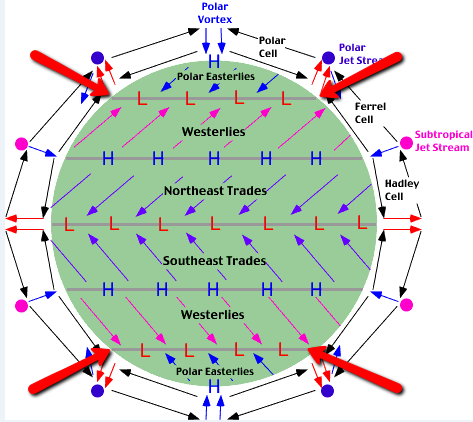Temperate Cyclone or Depression
Good day steemit friends, yesterday I explained the concept of tropical cyclone, today I will be writing on the temperate cyclone. The temperate, extratropical or mid-latitude cyclone or depression occurs in region along the polar front where the warm westerlies and cold polar winds converge. When a local low-pressure zone develops somewhere along the front, the front bulges. It forms within 30° and 50° latitude during winter months and grows into massive spiralling storms which can be 1000 miles wide.

Credit
Stages of a temperate cyclone
The first stage as it is show in the image above (fig.1) a boundary separates the warm and cold fronts.
In the second stage (fig.2), the front divides into two, which are, warm front where the warmer and therefore lighter westerlies slide over the colder and therefore heavier polar winds, and a cold front at the front of the polar winds where they undercut and lift the lighter westerlies from the rear.
Fig.3 in the image shows a full-grown depression. The two fronts together seperate the air into a warm sector where the warm air prevails and a cold sector where the cold polar air predominates.
In the fourth stage (fig.4), the polar air has succeeded in completely lifting the warm westerlies off the ground from the rear, making the cold air predominate all over at ground level. This last stage of depression is called an occlusion.
Winds are stong in a depression and ther blow spirally inwards in an anticlockwise direction in the northern hemisphere, towards the low pressure in the centre. In the southern hemisphere, they blow in a clockwise direction. It is warm in the warm sector, cold in the cold sector and rainy along both fronts.
Such a depression may be 300-500km across. The entire depression travels en masse northeastwards in the northern hemisphere, and southeastwards in the south.
A depression also gives rice to some warm and cold local winds in its wake like Sirocco of Algeria or Pampero of Argentina.
Reference
https://sciencing.com/stages-midlatitude-cyclones-8454789.html
http://www.physicalgeography.net/fundamentals/7s.html
http://sageography.myschoolstuff.co.za/wiki/grade-12-caps/climate-and-weather/mid-latitude-cyclones/
My climatology lecture notes.


You received a 80.0% upvote since you are a member of geopolis and wrote in the category of "geography".
To read more about us and what we do, click here.
https://steemit.com/geopolis/@geopolis/geopolis-the-community-for-global-sciences-update-4
If you do not want us to upvote and comment on your posts concerning earth and earth sciences, please reply stop to this comment and we will no longer bother you with our love ❤️
Excellent article, very informative! Thanks for sharing. Following you
Thanks for going through my post.
niece work bro, i the feel you
You never thought that the high pressure and cycle of cyclones could be one of the reasons people feel depressed and have panic attacks?
First of all, thank you for sharing this interesting article with us, donfelix. It was interesting information to read. About the depression question, I remember reading some research that says in some regions, people have more problems with depression/anxiety or need professional help/counseling for couples regarding marriage. I think they are pretty true because the pressure of the atmosphere in some regions can affect the human brain. If you find any information about this topic, please share it here. http://counsellinginmelbourne.com.au/everything-you-need-to-know-about-relationship-counselling